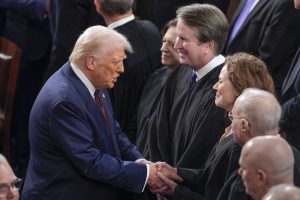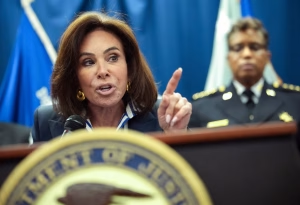On Thursday, November 6, 2025, a tense and confusing moment unfolded at the White House when a man suddenly collapsed during a live press conference. What might have been a brief medical emergency quickly turned into a national talking point — not because of the incident itself, but because of how United States Secretary of Health and Human Services Robert F. Kennedy Jr. reacted.
Kennedy, who was attending the event alongside President Donald Trump and several senior health-industry leaders, was seen on camera leaving the room immediately after the man fell. The clip spread rapidly across social media, igniting criticism, speculation, and debate over whether the nation’s top health official had abandoned his post in a moment of crisis.
Days later, eyewitness accounts would tell a very different story — one that painted Kennedy’s actions not as an act of indifference, but as a quick, practical response in the midst of chaos.
The Collapse That Stopped the Conference
The event was part of a White House conference focused on a new public-private partnership to accelerate access to advanced weight-loss medications. The East Room was filled with reporters, executives from leading pharmaceutical companies, and senior government figures.
As Eli Lilly CEO David Ricks delivered remarks on the company’s role in the agreement, a man standing nearby — later identified as a representative of one of the participating health-care firms — suddenly lost balance and fell to the floor.
“You OK?” Ricks asked as the sound of shifting chairs filled the room. Within seconds, Centers for Medicare and Medicaid Services Administrator Mehmet Oz and other nearby officials rushed toward the man.
Witnesses later described the scene as tense but orderly. Attendees gently lowered the man, elevated his legs, and checked his breathing and pulse. Reporters were quickly escorted out as medical personnel were called in.
President Trump, who had been standing at the podium, looked on for a brief moment with what appeared to be a neutral expression before the live feed was cut. Social media users soon seized upon that moment, but the real controversy emerged when footage showed Kennedy briskly exiting the room.
The Online Backlash
The video clip, replayed millions of times across social platforms, showed Kennedy turning and walking out as the commotion began. Without context, it appeared as though he had simply decided to leave in the middle of a medical emergency.
Comments poured in within minutes.
“RFK bailing out is killing me,” one user wrote.
Another added, “How you the Health and Human Services Secretary and you just walk off?”
A third post read, “RFK Jr.’s response to someone collapsing nearby him was to haul out of the room as quickly as possible.”
The criticism spread fast. Kennedy, the nation’s top public-health official, was accused of walking away instead of taking charge. Even casual observers questioned how someone holding that office could appear so detached in the face of a health crisis.
By the time the live broadcast resumed, the narrative was already taking shape: the man had fainted, the president had looked indifferent, and the health secretary had fled the scene.
What Really Happened, According to an Insider
Within hours, however, details began to surface that told a different story. According to an insider who was present at the event, Kennedy did not run off to avoid the situation — he left momentarily to get help.
“When the man first started to fall, Secretary Kennedy thought maybe he just needed to sit down,” the source explained. “He went into the next room to grab a chair.”
By the time Kennedy returned, the man was already lying on the floor and being tended to by several doctors who had been in attendance. Kennedy brought back not only a chair but also a wet towel, which he handed to the responders before stepping aside as they continued medical assistance.
The insider added that Kennedy made multiple trips in and out of the room, fetching items and calling for additional support. “As they were trying to prop him up, Kennedy ran back again and brought in another chair,” the source said. “He wasn’t abandoning the scene — he was trying to help.”
That account matched what White House Deputy Press Secretary Kush Desai later posted online: “The Secretary rushed to get medical assistance while others tended to the man, you ghoul,” he wrote in defense of Kennedy after critics accused him of walking away.
The Condition of the Collapsed Attendee
According to those present, the man’s condition initially appeared serious. He was conscious but pale, with a weak pulse and blood pressure that “was in the tank,” as one witness described.
Medical personnel soon arrived and took over. After several minutes, they stabilized the man, who was then transported out of the room on a gurney. The White House later confirmed that he was “OK” and recovering well.
When the conference resumed, President Trump addressed the interruption directly:
“One of the representatives of one of the companies got a little light-headed and went down, but he’s fine,” he said. “He’s got doctor’s care, but he’s fine. So we had a little bit of an interruption — sorry for that.”
The event then continued as scheduled, though the public’s attention remained fixed on Kennedy’s brief disappearance.
The Power of Perception
The reaction to the incident underscores a simple but powerful truth about public life: perception often outweighs reality.
From a purely functional standpoint, Kennedy’s actions were understandable. A person collapsed, and he immediately tried to find a chair and medical help. But in an era defined by viral clips and instant judgment, his departure looked like avoidance rather than assistance.
For an ordinary bystander, stepping out to get help might seem logical. But for a national health leader, visibility during a crisis carries its own weight. The American public expects figures like the Secretary of Health and Human Services to remain front-and-center — calm, composed, and reassuring.
Kennedy’s absence, even if brief, created a visual vacuum. To millions watching online, the image of the health secretary walking out while a man lay unconscious symbolized detachment from duty, even though his actions were, according to witnesses, motivated by concern.
Lessons in Optics and Leadership
The incident provides an important case study in how quickly narratives form in the age of real-time media. It also highlights several key lessons for public officials.
1. Presence Matters.
In any emergency, particularly in front of cameras, staying visible is crucial. Even if others are handling the situation, leaders are expected to project steadiness and control.
2. Intent Is Invisible.
Kennedy’s apparent decision to leave was driven by a desire to help, yet his reasoning was invisible to the cameras. The public saw only the movement, not the motive.
3. Every Second Is Scrutinized.
High-profile events are documented from multiple angles. Every facial expression, gesture, or step becomes open to interpretation. In such environments, even well-intentioned actions can be misread.
4. Communication Must Be Swift and Clear.
Had the White House clarified Kennedy’s role immediately, the backlash might have been contained. Instead, the explanation arrived hours later, after the online narrative had already solidified.
Kennedy’s Broader Context
The episode also drew attention because of who Robert F. Kennedy Jr. is. As a member of the Kennedy political family and a polarizing figure in American public health, his every move attracts scrutiny.
Since taking over as Health and Human Services Secretary earlier in 2025, Kennedy has led several major health initiatives and has sought to reshape aspects of the department’s approach to preventive care. Supporters praise his willingness to challenge entrenched bureaucratic norms; critics accuse him of erratic leadership and controversial public-health views.
That background meant that this single incident — a split-second reaction during an unexpected emergency — was viewed through a wider lens of political and personal history. To his detractors, it confirmed a lack of composure. To his defenders, it was another example of how quickly he is unfairly judged.
Aftermath and Takeaway
In the end, the man who collapsed recovered, the event resumed, and Kennedy’s actions were clarified by eyewitnesses and White House staff. Yet the moment remains a reminder of how fragile public perception can be.
The contrast between the truth and the viral image is stark: Kennedy did not run away; he ran to get help. But for millions who only saw the clip, that distinction may never be made.
In the days that followed, Kennedy made no formal statement about the incident, perhaps preferring not to amplify it further. Instead, his aides emphasized his hands-on response and the swift medical assistance provided.
Still, the episode left a lasting impression on the public conversation about leadership under pressure. It raised the question of whether leaders should prioritize visible presence or practical action when emergencies strike. The answer, as this case shows, may depend not just on what one does — but on how it looks while doing it.
Final Reflection
Robert F. Kennedy Jr.’s split-second decision to leave the room that day was likely made in good faith — a human reaction to help someone in distress. But in the glare of political life, good faith is not always enough. Every movement, every expression, every decision becomes a symbol.
The irony of this particular moment — that the nation’s chief health official was criticized for his conduct during a health emergency — speaks to the unique pressures of leadership in the digital era. Intent can be righteous, but optics can still betray it.
In the end, the incident was not a story about neglect or cowardice, but about perception, context, and the unforgiving speed of modern media. For Kennedy, it was a brief but vivid reminder that in Washington, appearances don’t just matter — they define the story.

Emily Johnson is a critically acclaimed essayist and novelist known for her thought-provoking works centered on feminism, women’s rights, and modern relationships. Born and raised in Portland, Oregon, Emily grew up with a deep love of books, often spending her afternoons at her local library. She went on to study literature and gender studies at UCLA, where she became deeply involved in activism and began publishing essays in campus journals. Her debut essay collection, Voices Unbound, struck a chord with readers nationwide for its fearless exploration of gender dynamics, identity, and the challenges faced by women in contemporary society. Emily later transitioned into fiction, writing novels that balance compelling storytelling with social commentary. Her protagonists are often strong, multidimensional women navigating love, ambition, and the struggles of everyday life, making her a favorite among readers who crave authentic, relatable narratives. Critics praise her ability to merge personal intimacy with universal themes. Off the page, Emily is an advocate for women in publishing, leading workshops that encourage young female writers to embrace their voices. She lives in Seattle with her partner and two rescue cats, where she continues to write, teach, and inspire a new generation of storytellers.









